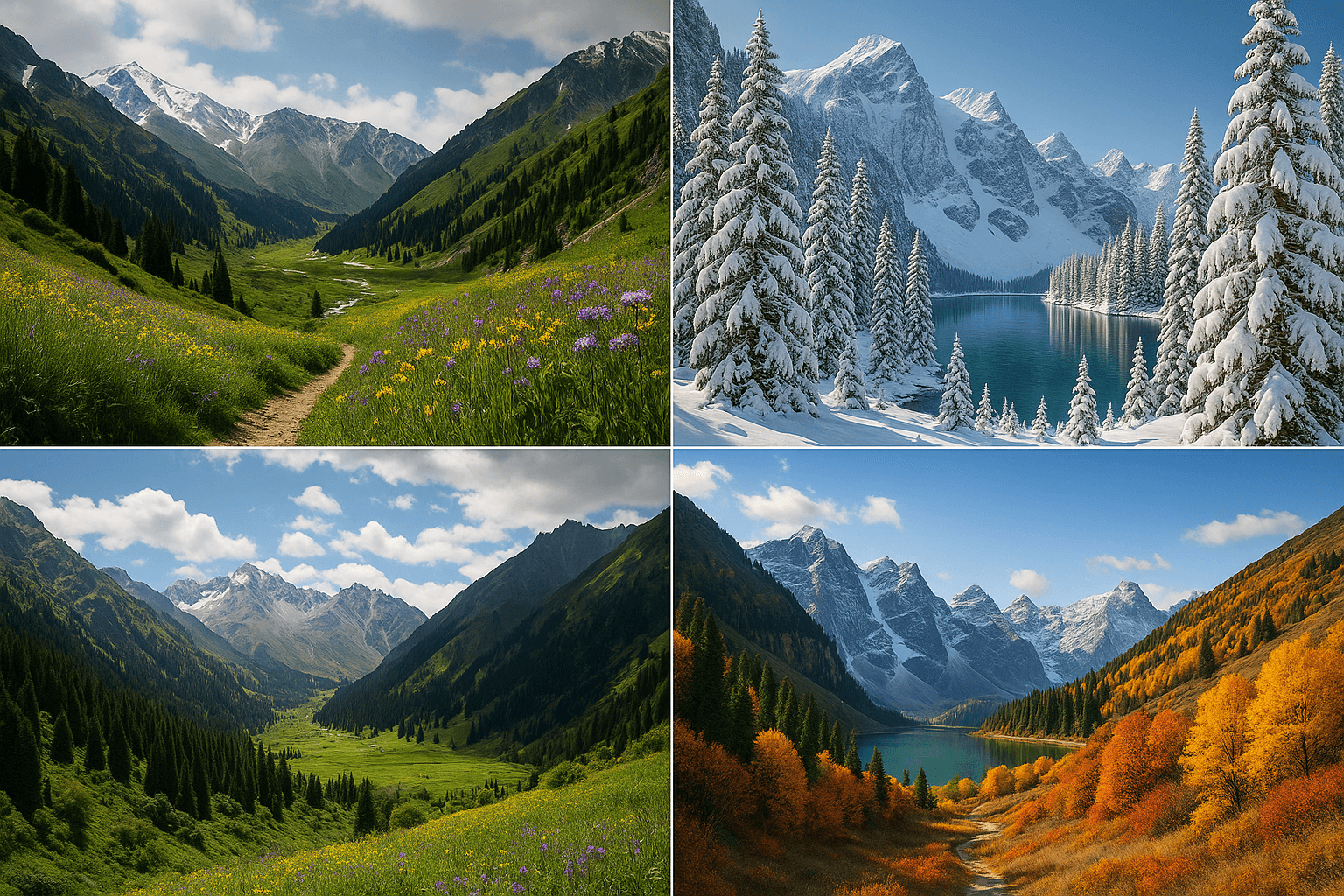Introduction
The mountainous region of the Zailiyskiy Alatau, located near Almaty, is climatically diverse. Elevation here ranges from 1500 to over 4000 meters, and weather conditions strongly depend on altitude. Even a 500-meter difference can dramatically affect the environment.
This article provides a month-by-month breakdown of weather conditions in the Almaty mountains and includes advice for those planning treks, ski tours, or hiking in Kazakhstan.
January — Cold, Sun, and Deep Snow
January is the coldest month in the mountains of Almaty. At altitudes above 2500–3000 m, nighttime temperatures consistently drop to -18…-22°C, and during the day they range around -10…-12°C. In the valleys (such as the Medeu area), it can be slightly warmer — up to -5°C during the day.
Despite the frost, January is known for its clear, dry weather. Low humidity and stable atmospheric pressure create excellent conditions for skiing, snowboarding, and winter trekking.
Tourist features:
- The snow cover is stable and deep, especially on northern slopes.
- In the high mountains (e.g., Pik Turist or Talgar), wind and icing make movement difficult.
- Areas above 3200 m are often windswept, and snow gets blown off quickly.
Tip: For trekking, it’s best to choose lower belts — up to 2500 m. Mountaineers should only go higher with proper acclimatization and equipment.
February — Winter Stability and the Beginning of Spring Sun
February is almost as cold as January, but the sun becomes more active. On clear days, a slight warming is felt, especially in lower elevations (Medeu, Shymbulak).
At elevations above 3000 m, temperatures still drop to -15…-20°C at night. Snow continues to accumulate, and by mid-month the avalanche season begins, especially on northeast-facing slopes.
Tourist features:
- An excellent month for freeride and ski touring.
- Extra caution is needed due to avalanche risk.
- Conditions in the valleys are favorable for day hikes without overnight stays.
March — The Transition from Winter to Spring
March weather is extremely variable. At elevations up to 2000 m, thaws may begin, while above 2500 m winter still holds its ground. Temperature swings (up to +2°C during the day and down to -10°C at night) lead to the formation of icy crust on trails.
Sunny days alternate with heavy snowfalls. The number of wet avalanches increases, especially during sudden warm spells.
Tourist features:
- A good time for experienced skiers — the snow becomes stickier, which suits spring skiing.
- Hiking routes are only possible on northern slopes and with early starts.
April — Mud and Snowfalls
April is one of the most difficult months for trekking. Lower mountain trails become muddy due to persistent rain, while higher elevations are still covered in deep, wet snow. Avalanches continue to occur frequently, especially during warm spells.
Tourist features:
- High risk of wet snow avalanches, especially in the afternoon.
- Trails are flooded, slippery, and physically demanding.
- On peaks like Pik Turist (3954 m), spring skiing conditions can still be excellent.
Tip: Avoid long-distance hikes unless conditions are stable. Focus on short trips in drier valleys.
May — Nature Awakens
Snow recedes from lower slopes, and alpine valleys begin to bloom with early spring flowers. However, snow still lingers above 3000 meters, and high-mountain conditions remain wintry.
Tourist features:
- Trails up to 2500 m are mostly snow-free and suitable for trekking.
- Above 3000 m, snowpack remains thick and may require snowshoes.
- Ideal for mid-altitude hikes and nature photography.
Tip: Dress in layers — temperatures vary widely between valleys and ridges.
June — Spring in the High Mountains
Though it’s officially summer, the upper mountains still feel like late spring. Snow remains in some gullies and on shaded slopes. Afternoon thunderstorms are common.
Tourist features:
- Most classic routes open by mid-June.
- Possible snowfall above 3600 m during early June.
- Abundant meltwater — rivers and streams run high.
Tip: Start hikes early in the morning to avoid afternoon storms and slippery trails.
July — Peak Summer Conditions
July offers the most stable and warm conditions of the year. Temperatures at 2000 m can reach +20°C, and skies are mostly clear. All routes, including high alpine trails and glacier approaches, are accessible.
Tourist features:
- Perfect for multi-day treks and camping.
- Safe access to alpine lakes, passes, and peaks.
- Snow on glaciers becomes firmer and easier to navigate.
Tip: Use sunscreen — UV radiation is intense at high altitudes.
August — Ideal for All Activities
August continues July’s pleasant weather, with even drier and more predictable conditions. By late August, nights become cooler, especially above 2500 m. Glaciers are wide open and stable.
Tourist features:
- Excellent visibility and minimal precipitation.
- Suitable for trekkers of all skill levels.
- First light snowfall may occur above 3500 m near end of month.
Tip: Book popular routes and huts in advance — it’s peak tourist time.
September — Velvet Season
Early fall is often considered the best time to visit the Almaty mountains. Temperatures are mild, trails are dry, and the forests begin to turn golden.
Tourist features:
- Ideal conditions for photographers and hikers.
- Fewer crowds than in summer.
- Most routes still accessible before the first frost.
Tip: Best month for beginners to try multi-day routes in comfort.
October — Golden Autumn
Forests are ablaze with yellow and orange foliage. Frosts begin at night, and high trails may become icy. Still, the air remains dry and crisp — perfect for hiking.
Tourist features:
- Stunning landscapes and vivid fall colors.
- Snow may return to elevations above 3000 m.
- Trails become slippery, especially in the mornings.
Tip: Plan hikes earlier in the day and avoid shaded slopes.
November — First Frost and Snow
November marks a sharp drop in temperatures. At 2500 m, trails begin to freeze. Snow accumulates steadily toward the end of the month.
Tourist features:
- Low visibility and early snowfalls are common.
- Trekking season ends — conditions become risky.
- Some valley trails still passable in early November.
Tip: Switch to winter gear or consider ski touring prep.
December — Winter Takes Hold
By December, the snowpack is solid enough for full ski resort operations. Frosts intensify, but the sun still shines often, providing beautiful mountain panoramas.
Tourist features:
- Great conditions for skiing and snowboarding.
- Stable snow on prepared trails.
- Crisp, sunny days — excellent for winter photos.
Tip: Dress for extreme cold at night, especially above 2000 m.


0 Comment